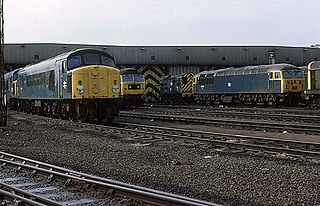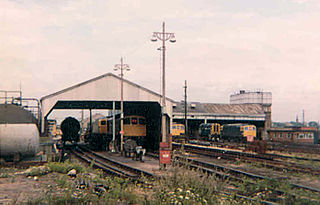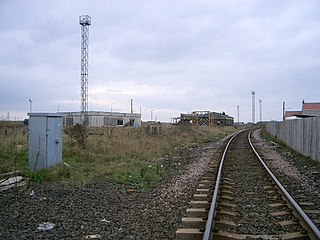
A switcher, shunter, yard pilot, switch engine, yard goat, or shifter is a small railroad locomotive used for manoeuvring railroad cars inside a rail yard in a process known as switching (US) or shunting (UK). Switchers are not intended for moving trains over long distances but rather for assembling trains in order for another locomotive to take over. They do this in classification yards. Switchers may also make short transfer runs and even be the only motive power on branch lines and switching and terminal railroads. The term can also be used to describe the workers operating these engines or engaged in directing shunting operations. Switching locomotives may be purpose-built engines, but may also be downgraded main-line engines, or simply main-line engines assigned to switching. Switchers can also be used on short excursion train rides.

Knottingley railway station serves the town of Knottingley in West Yorkshire, England. It lies on the Pontefract Line, operated by Northern, and is 16 miles (26 km) south east of Leeds railway station.

A merry-go-round train, often abbreviated to MGR, is a block train of hopper wagons which both loads and unloads its cargo while moving. In the United Kingdom, they are most commonly coal trains delivering to power stations. These trains were introduced in the 1960s, and were one of the few innovations of the Beeching axe, along with investment from the CEGB and the NCB into new power stations and loading facilities.

St Blazey Engine Shed is located in Par, Cornwall, United Kingdom, although it is named after the adjacent village of St Blazey. It was built in 1874 as the headquarters of the Cornwall Minerals Railway but for many years was a depot of the Great Western Railway. The current depot operator is DB Cargo and the depot TOPS code is BZ.

Immingham engine shed, also known as Immingham depot, or more recently as Immingham TMD and always locally as Loco is a railway maintenance depot located on the Immingham Dock estate, in North East Lincolnshire, England. The depot code is IM.

Neville Hill is a railway train maintenance depot in Osmondthorpe, Leeds, England on the Leeds to Selby Line. The depot is situated 2 miles 14 chains (3.5 km) to the east of Leeds railway station on the north side of the line.

Landore TMD is a railway traction maintenance depot situated in Landore, a district of Swansea, Wales. There was a shed for steam locomotives here, and in 1963 British Rail opened a purpose-build diesel depot. Under privatisation the depot was operated by Great Western Railway to service its fleet of InterCity 125s until it closed in December 2018. The site reopened in September 2019 as a rolling stock refurbishment centre.

Thornaby TMD was a railway traction maintenance depot situated in Thornaby, England, latterly operated by DB Schenker. The depot was situated to the east of Thornaby, on the northern side of the line to Middlesbrough.

Toton Traction Maintenance Depot or Toton Sidings is a large traction maintenance depot located in Toton, Nottinghamshire. The TOPS depot code for the depot is TO. Before TOPS, the shed code was 16A.

Hither Green (London) Traction Maintenance Depot or Hither Green (London) TMD is a railway depot used for the maintenance and servicing of freight trains adjacent to the Hither Green marshalling yard. The depot is a hub for moving freight around southeast England. Hither Green TMD is owned and operated by DBS. The official depot code is HG. In steam days the shed code was 73C.

Whistlestop Valley, formerly the Kirklees Light Railway, is a visitor attraction featuring a 3+1⁄2-mile (5.6 km) long 15 in gauge minimum gauge railway. The attraction's main site is in the village of Clayton West in Kirklees, West Yorkshire, England which was first opened to the public on 19 October 1991, with a second, smaller site in a rual area near the village of Shelley.

Holbeck TMD is a traction maintenance depot located in Holbeck, Leeds, England. The depot is located on the west side of the line from Woodlesford, and is 57 chains (1.1 km) south of Leeds railway station.

Botanic Gardens TMD was an engine shed in Kingston upon Hull in Yorkshire, England. As one of the principal engine sheds in the Hull area, Botanic Gardens was the one closest to the main Hull Paragon station and its locomotives were responsible for working passenger services in the area. This entry also covers the engine sheds in the Paragon area that preceded Botanic Gardens.

Coldham Lane Depot is a traction maintenance depot located in Cambridge, Cambridgeshire, England. The depot is situated on the eastern side of the Fen Line and is to the north of Cambridge Station.

Blyth Cambois TMD was a traction maintenance depot located in Blyth, Northumberland, England. The depot was situated on the west side of the branch line from Bedlington Junction to Blyth Docks.

Leeds Midland Road depot is a locomotive and rolling stock maintenance facility located in Leeds, West Yorkshire, England. The site is located a few miles to the south-west of Leeds station on the line between Leeds and Castleford. Owned and operated by Freightliner, it is the heavy maintenance facility for its diesel and electric locomotives and wagon fleet.

Healey Mills Marshalling Yard was a railway marshalling yard located in the village of Healey, south west of Ossett in West Yorkshire, England. The yard was opened in 1963 and replaced several smaller yards in the area. It was part of the British Transport Commission's Modernisation plan, and so was equipped with a hump to enable the efficient shunting and re-ordering of goods wagons. The yard lost its main reason for existence through the 1970s and 1980s when more trains on the British Rail system became block trains where their wagons required less, or more commonly, no shunting.

Basford Hall Yard is a railway marshalling yard near the town of Crewe, Cheshire, England. The yard, which is 0.93 miles (1.5 km) south of Crewe railway station, was opened in 1901 by the London and North Western Railway (LNWR). Initially used to marshal trains, the site now acts as a hub mainly for Freightliner intermodal trains, but also houses departmental sidings as used by Freightliner Heavy Haul, and other operators. For a period in the 1930s, Basford Hall was the busiest marshalling yard in Europe, handing between 28,000 and 47,000 wagons every week.

Milford Sidings are a set of railway sidings in South Milford, North Yorkshire, England. The railways through the site were initially opened in 1834 and 1840, when transfer and marshalling yards opened too, which handled mostly coal. However, the current sidings were developed in the 1980s to function as layover sidings for coal trains to and from the Aire Valley power stations. The sidings have access to several railway lines radiating in almost all directions.




















